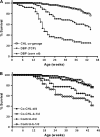Identifying efficacious approaches to chemoprevention with chlorophyllin, purified chlorophylls and freeze-dried spinach in a mouse model of transplacental carcinogenesis
- PMID: 19073876
- PMCID: PMC2722150
- DOI: 10.1093/carcin/bgn280
Identifying efficacious approaches to chemoprevention with chlorophyllin, purified chlorophylls and freeze-dried spinach in a mouse model of transplacental carcinogenesis
Abstract
The carcinogenic potential of dibenzo[a,l]pyrene (DBP) has been well characterized in numerous animal models. We have previously documented that a single dose of 15 mg/Kg DBP to pregnant mice late in gestation (GD 17) produces an aggressive T-cell lymphoma as well as lung and liver cancer in offspring. The current study examines the chemopreventative properties of chlorophyllin (CHL) and chlorophyll (Chl) in this transplacental carcinogenesis model. Pregnant B6129SF1 females, bred to 129S1/SvIm males, received purified diets incorporated with either 2000 p.p.m. CHL, 2000 p.p.m. Chl or 10% freeze-dried spinach beginning at gestation day 9. Lymphoma-dependent mortality was not significantly altered by maternal consumption of any of the diet and little effect on lung tumor burden in mice surviving to 10 months of age was observed. However, coadministration of CHL at 380 mg/Kg with DBP by gavage (molar ratio of 10:1, CHL:DBP) provided significant protection against DBP-initiated carcinogenesis. Offspring born to dams receiving CHL co-gavaged with DBP exhibited markedly less lymphoma-dependent mortality (P < 0.001). The degree of protection by CHL, compared with controls dosed with DBP in tricaprylin (TCP) as the vehicle, was less marked, but still significant. Coadministration of CHL (TCP as vehicle) also reduced lung tumor multiplicity in mice by approximately 50% and this was observed throughout the study (P < 0.005). This is the first demonstration that CHL can provide potent chemoprotection in a transplacental carcinogenesis model and support a mechanism involving complex-mediated reduction of carcinogen uptake.
Figures



Similar articles
-
Chemoprevention of dibenzo[a,l]pyrene transplacental carcinogenesis in mice born to mothers administered green tea: primary role of caffeine.Carcinogenesis. 2008 Aug;29(8):1581-6. doi: 10.1093/carcin/bgm237. Epub 2008 Jul 16. Carcinogenesis. 2008. PMID: 18635525 Free PMC article.
-
The importance of carcinogen dose in chemoprevention studies: quantitative interrelationships between, dibenzo[a,l]pyrene dose, chlorophyllin dose, target organ DNA adduct biomarkers and final tumor outcome.Carcinogenesis. 2007 Mar;28(3):611-24. doi: 10.1093/carcin/bgl174. Epub 2006 Sep 14. Carcinogenesis. 2007. PMID: 16973675
-
Indole-3-carbinol in the maternal diet provides chemoprotection for the fetus against transplacental carcinogenesis by the polycyclic aromatic hydrocarbon dibenzo[a,l]pyrene.Carcinogenesis. 2006 Oct;27(10):2116-23. doi: 10.1093/carcin/bgl072. Epub 2006 May 16. Carcinogenesis. 2006. PMID: 16704990
-
Chemopreventive properties of chlorophylls towards aflatoxin B1: a review of the antimutagenicity and anticarcinogenicity data in rainbow trout.Mutat Res. 1998 Mar 20;399(2):245-53. doi: 10.1016/s0027-5107(97)00259-5. Mutat Res. 1998. PMID: 9672663 Review.
-
The rainbow trout liver cancer model: response to environmental chemicals and studies on promotion and chemoprevention.Comp Biochem Physiol C Toxicol Pharmacol. 2012 Jan;155(1):121-7. doi: 10.1016/j.cbpc.2011.05.013. Epub 2011 Jun 16. Comp Biochem Physiol C Toxicol Pharmacol. 2012. PMID: 21704190 Free PMC article. Review.
Cited by
-
Cancer interception by interceptor molecules: mechanistic, preclinical and human translational studies with chlorophylls.Genes Environ. 2021 Mar 6;43(1):8. doi: 10.1186/s41021-021-00180-8. Genes Environ. 2021. PMID: 33676582 Free PMC article. Review.
-
Indoles Derived From Glucobrassicin: Cancer Chemoprevention by Indole-3-Carbinol and 3,3'-Diindolylmethane.Front Nutr. 2021 Oct 1;8:734334. doi: 10.3389/fnut.2021.734334. eCollection 2021. Front Nutr. 2021. PMID: 34660663 Free PMC article. Review.
-
Human in Vivo Pharmacokinetics of [(14)C]Dibenzo[def,p]chrysene by Accelerator Mass Spectrometry Following Oral Microdosing.Chem Res Toxicol. 2015 Jan 20;28(1):126-34. doi: 10.1021/tx5003996. Epub 2014 Dec 10. Chem Res Toxicol. 2015. PMID: 25418912 Free PMC article. Clinical Trial.
-
DNA methylation in lung tissues of mouse offspring exposed in utero to polycyclic aromatic hydrocarbons.Food Chem Toxicol. 2017 Nov;109(Pt 1):703-713. doi: 10.1016/j.fct.2017.04.047. Epub 2017 May 2. Food Chem Toxicol. 2017. PMID: 28476633 Free PMC article.
-
MicroRNA profiling of carcinogen-induced rat colon tumors and the influence of dietary spinach.Mol Nutr Food Res. 2012 Aug;56(8):1259-69. doi: 10.1002/mnfr.201200117. Epub 2012 May 29. Mol Nutr Food Res. 2012. PMID: 22641368 Free PMC article.
References
-
- Young RW, et al. Use of chlorophyllin in the care of geriatric patients. J Am. Geriatr. Soc. 1980;28:46–47. - PubMed
-
- Dashwood R. Chlorophylls as anticarcinogens. Int. J. Oncol. 1997;10:721–727. - PubMed
-
- Negishi T, et al. Antigenotoxic activity of natural chlorophylls. Mutat. Res. 1997;376:97–100. - PubMed
-
- Breinholt V, et al. Dietary chlorophyllin is a potent inhibitor of aflatoxin B1 hepatocarcinogenesis in rainbow trout. Cancer Res. 1995;55:57–62. - PubMed
-
- Dashwood R, et al. Chemopreventive properties of chlorophylls towards aflatoxin B1: a review of the antimutagenicity and anticarcinogenicity data in rainbow trout. Mutat. Res. 1998;399:245–253. - PubMed
Publication types
MeSH terms
Substances
Grants and funding
LinkOut - more resources
Full Text Sources
Other Literature Sources
Medical

